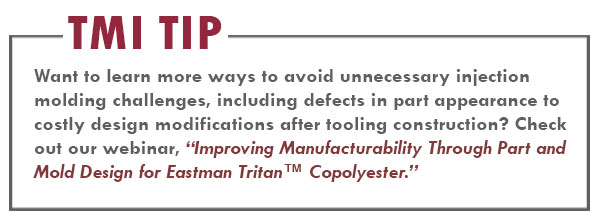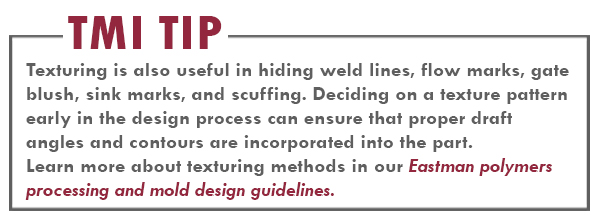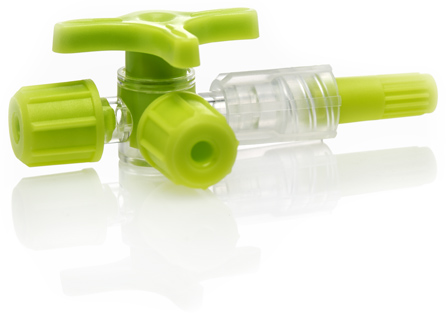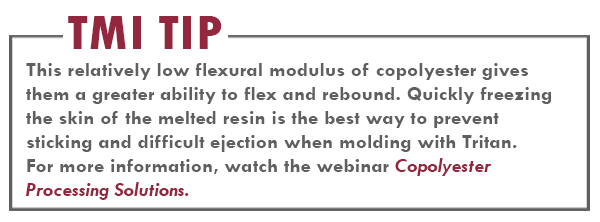7
When using a mold designed for other plastics to run Eastman Tritan™ copolyester, good cooling is absolutely critical. Proper cooling helps you obtain lower cycle times and high-quality parts while reducing cost. Poor cooling, however, can lead undesirable effects, including mold shrinkage and warpage.
To minimize shrinkage, remember these key factors:
Uniform wall thickness
A uniform wall promotes even flow, minimizes shear heating, reduces molded-in stress, and tends to minimize warpage.
Consistent mold temperatures
A uniform mold temperature helps ensure even heat transfer from both wall surfaces. This will leave the part in a balanced condition, provided the wall thickness is uniform. The mold should be designed for adequate control of the temperature in the range required for the material being processed. This will not only decrease the amount of residual stress, but will also permit reduction of cycle time.
Every combination of existing mold properties and molding requirements is different. Tritan™ experts can review your cooling techniques to help you minimize shrinkage in your old mold.

12
Here are four tooling design tips for injection molding with Eastman TritanTM copolyester:
Proper gating selection
- Most conventional cold gating styles work well with TritanTM copolyesters, including sub, pin, fan, edge, sprue, and diaphragm gates. Self-degating gate styles, such as sub gates or pin gates, typically require smaller gate sizes balancing the ability to limit pressure drop with degating.
- For hot runner systems, valve gates should be used. Critical design features of TritanTM valve gate systems include thermal control and independent water supply.
- Tritan™ copolyesters require good thermal control throughout the cavity for optimal processing.
- Injection molding gates typically have the highest heat load in an injection mold.
- Higher thermal conductivity steels allow greater heat transfer rates, potentially reducing cycle time and providing a more uniform cavity temperature.
- The inability to remove air from the cavity can result in part appearance defects such as incomplete fill (or short shots) and burn marks due to heat of compression of the escaping air.
- Suggested vent depths for Tritan™ copolyesters are typically 0.0005′′–0.0015′′.
- Parts should be adequately supported during ejection to avoid part deformation/breakage.
- Part design features like long cores or deep ribs with minimal draft can result in high forces being placed on the molded part during this process.
- Tritan™ copolyesters have a relatively low modulus (i.e. are more flexible) and yield strength compared to some competitive transparent resins. Contact us today.

10
Eastman Tritan™ copolyester provides excellent gloss and picks up mold finish very well. When using it in a mold designed for other plastics, however, there are factors you need to consider in order to achieve success.
Here are some guidelines for polishing Eastman Tritan™ copolyester:
- Specify SPI mold finish standards.
- Specify surfaces smooth enough to minimize ejection force.
- Specify final polish in the direction of draw to minimize scuffing.
- Add a light 320 dry grit blasting (SPI B3 finish) to drafted walls to reduce the possibility of a vacuum forming during ejection.
It’s important to keep in mind that surfaces polished smoother than required for ejection add to mold cost. In most cases, highly polished surfaces can hinder ejection if there is a vacuum drawn in low or no draft areas. Where no vacuum is drawn, polished surfaces generally eject better.
You may encounter the risk of surface defects when polishing Eastman Tritan™ copolyester. To prevent them, remember these tips:
- Pay attention to the part design if a surface finish is expected on the final product. Abrupt changes in wall thickness, relatively thick sections, or heavy ribs can cause variations in surface gloss. Uniform mold temperatures are needed to ensure that the texture is even throughout the pattern.
- To achieve a higher matte finish, double or triple the texture etching.
- If weld lines are visible on the final product, one alternative is to move the gate positions so that the weld line is formed in a less visible place. If this is not possible, apply a rounded texture pattern to help hide the blemish.
- If the material you are molding is expected to have poor scratch resistance, use a rounded texture pattern to hide potential marks.
Every combination of existing mold properties and molding requirements is different. Tritan™ experts can review your polishing and texturing methods and help you evaluate the results of optimizing your old mold.

23
 Selecting the right material for your next medical device can be a complicated process. Whether you’re building a fluid management component, blood contact device, or electronic medical device housing, you’ll want to choose a polymer that has the right properties for your application.
Selecting the right material for your next medical device can be a complicated process. Whether you’re building a fluid management component, blood contact device, or electronic medical device housing, you’ll want to choose a polymer that has the right properties for your application.Each medical grade of Eastman Tritan™ copolyester offers a different combination of superior strengths that help optimize performance for specific medical applications. Depending on the needs of your device, you may need a clear or opaque material.
Clear applications
If your device is clear, such as fluid management and IV components, renal devices, or dialyzer housings, you’ll need a material with the following properties:
- Glasslike clarity for an unobstructed view of fluid levels, foreign substances, and the ability to detect air bubbles, clots, or blood leakage during treatment
- Durability and toughness to withstand the applied stress of handling, connecting, and fabricating
- Chemical resistance to endure aggressive cleaning and bonding agents as well as harsh drugs and their carriers
- Color stability after sterilization
- Biocompatibility with FDA/ISO 10993 and USP Class VI biological evaluation
- Heat resistance
- Specific rigidity requirements to comply with ISO 80369 (required in some connectors)
Eastman Tritan™ MX711, MX731, or MX811 copolyesters are clear material grades that meet these needs. They have high impact strength and toughness, excellent clarity, elevated chemical resistance, and good color stabilization upon sterilization.
Opaque applications
Opaque medical housings and hardware require a different set of properties than clear applications. For an opaque application, you’ll need a material that can deliver:
- Superior chemical resistance and impact strength to resist cracking, breaking, and premature device failure during rigorous daily use and disinfection
- Ability to retain finish after repeated applications of bleach and alcohol
- Color stability and matching of brand standards
- Less noise in devices where sound reduction is valued
- Processability—moldability and resistance to solvents
- Flame resistance
Find more information here about the advantages of Tritan for a wide range of medical applications. Eastman also provides technical expertise and support to help determine your best material option. Contact us for help bringing your product to market quickly and efficiently.

6
The success of Eastman Tritan™ copolyester—especially in medical devices—makes more brand owners want to try it. One challenge to even
greater success has been how to use molds designed for other plastics. Sometimes it works fine - sometimes not so much.
Successful molding of any polymer depends on the ability to fill the part, cool the mold, and “freeze” the melted resin. Failure to do
so can cause sticking and ejection molding difficulty—which can limit the number of parts per hour and the quality of the parts.
Since most competitive materials freeze off at a higher temperature than Tritan, the mold may now need to cool more efficiently and
quickly than the original design. Engineering solutions that are straightforward when a customer builds a new mold for a different resin
can become challenges when a molder wants to produce high-quality Tritan parts by optimizing “this old mold.”
The basics
- The suggested mold temperature for running Tritan is 38°–66°C (100°–150°F).
- Uniform temperature throughout the mold helps ensure even heat transfer from both wall surfaces, which decreases residual stress and warpage and reduces cycle time. When optimizing an existing mold, keep this in mind so upgrades do not upset existing dynamics.
- Tower water may be adequate, but we strongly recommend using chillers to ensure a proper supply of cool water to the molds. Properly sized pumps and supply lines are also critical.
Typical modifications
Here are the most common actions required when optimizing existing molds to run Tritan.
- Consider the theramal conductivity of the mold material. This is one variable you can't change, so it's important to factor it into all changes you can make.
- Evaluate the current cooling line layout, and make sure all changes are made to achieve uniform cooling.
- Make sure you have a turbulent water flow in the lines—laminar flow only has ½ the cooling efficiency of turbulent flow. Changing flow dynamics may be more cost-effective than changing diameter of the coolant channel.
- Use baffles or bubblers to achieve proper core cooling.
- Consider circular cooling channels around the cavity and core inserts.
- Injection molding gates typically have the highest heat load in an injection mold
- Increased cooling efficiency here can pay big dividends.
- Consider adding cooling lines adjacent to sprues.
- Spiral cooling sprue inserts or high-conductivity sprue bushings can be cost-effective retrofits.
- Poor venting can result in incomplete fill, increased pressure heat, and bum marks.
No old mold is typical
Every combination of existing mold properties and molding requirements is different. Because your needs are unique, we recommend involving Eastman as early in the planning as possible. Contact the Tritan Experts.
Eastman can review your tooling drawings and help you plan for uniform mold cooling. The Tritan experts can also help you evaluate the results of optimizing your old mold.






 Close
Close


